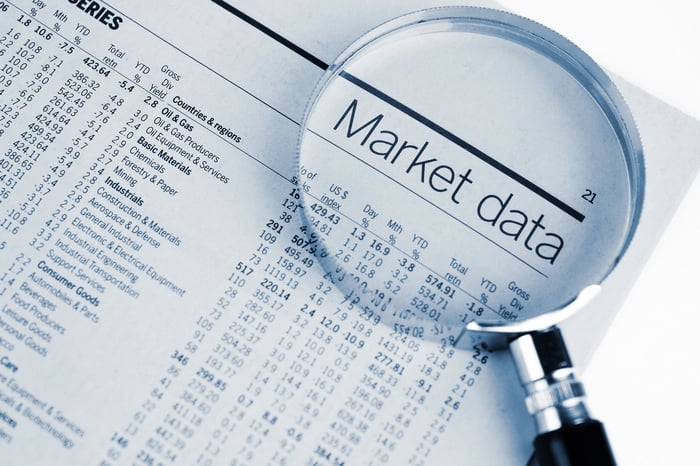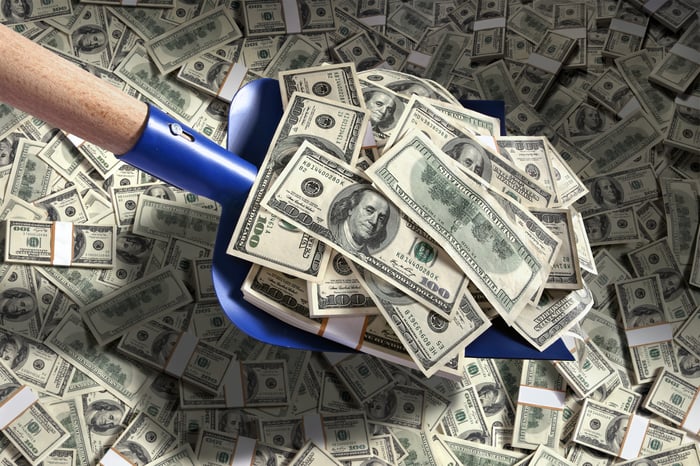There's probably no fundamental metric that investors follow more closely than the price-to-earnings ratio. Unfortunately, this bare-bones metric doesn't always tell you the full story about a company. In fact, some companies with currently unsightly P/E ratios may look expensive, but they're actually pretty cheap once you dig below the surface.
With this in mind, we asked three of our Foolish contributors to single out a company that may look expensive on paper but is actually cheap if you dig below the surface. The three stocks that came to mind were biotech royalty company Ligand Pharmaceuticals (LGND -1.11%), auto-parts manufacturer BorgWarner (BWA -1.72%), and e-commerce retail giant Amazon.com (AMZN -2.81%).

Image source: Getty Images.
"Royalty" among biotech stocks
Sean Williams (Ligand Pharmaceuticals): When I think of a company that looks pricey but is actually far from it, Ligand Pharmaceuticals jumps to the top of the list.
Ligand Pharmaceuticals isn't your traditional drug-development company. Instead of discovering therapies and taking them through the arduous and costly process of preclinical and clinical-stage studies, Ligand focuses on the mere discovery of new therapeutic candidates and licenses out its proprietary technology that can enhance the ability of drugs to perform. In other words, it's more of a royalty biotech stock than a standard drug developer. The allure of the royalty model is that there's often little in the way of overhead costs, meaning very little in sales is needed to turn a profit.
In 2017, according to Wall Street's consensus, Ligand is expected to generate $2.71 in full-year EPS. That places Ligand at nearly 42 times this year's profit projections and about 18 times sales. Those are figures that would normally have value investors fleeing in droves.
But, here's what surface-scratching investors are missing: a truly massive licensed portfolio. In 2008, Ligand's technology was involved in the development of nine experimental-stage therapies. As of March, it's a part of more than 155. The same goes for approved products, with this figure jumping from one in 2008 to 15 in 2017. By 2020, Ligand predicts that the number of commercialized products could nearly double to 28. Meanwhile, Ligand earns royalties on the net sales of these products that currently work out to between 4% and 4.5%.

Image source: Getty Images.
In plainer English, having so many opportunities (155-plus) to find success is expected to nearly triple the company's sales between 2016 and 2020. Wall Street also foresees EPS more than doubling between 2017 and 2020 to an estimated $6.33 per share. The all-important figure here is that the company's PEG ratio (a measure of its P/E in relation to its growth rate) is just 1.2, and anything near 1 is considered to be inexpensive.
Although short-sellers hold approximately 25% of all shares short and are betting against Ligand's stock based on valuation, this looks to be a pretty cheap stock that could surprise pessimists.
Misleading metrics
Daniel Miller (BorgWarner): If you love investing, or just love business in general, searching for the next diamond-in-the-rough stock can be enjoyable. Surfing through the list of companies on your favorite screener and learning about companies you didn't know existed comes with risks, though, especially considering many metrics fall short of telling the full story. You'd be hard pressed to find a better example than BorgWarner, which supplies vehicle components and systems to the automotive industry. Investors commonly use a trailing price-to-earnings ratio to sort stocks in hopes of unearthing a value play, but without context, BorgWarner looks much more expensive than it really is. According to Yahoo! Finance, BorgWarner trades at an eye-popping trailing-12-month P/E ratio of 62.
But here's what that ratio doesn't tell you: It doesn't tell you about the company's non-cash asbestos-related charge during the fourth quarter that cost the company $2.07 per share off its net income. Guess what? Business at BorgWarner is good, and the company recently posted a first quarter that came in ahead of guidance.

A turbocharger. Image source: Getty Images.
Over the long term, BorgWarner's business is positioned to thrive thanks to industry trends of more stringent air and emissions rules, as well as increasing consumer demand for more fuel-efficient vehicles. In the near term, management was even confident enough to raise its full-year guidance by $0.15 per share up to a range of $3.35 to $3.45. That has BorgWarner trading at roughly 12 times its forward P/E, a night-and-day difference from its 62 trailing P/E.
While it's fun to quickly screen through a pile of stocks based on certain metrics, without the proper context it's all too easy to misunderstand a stock like BorgWarner that looks expensive but is actually cheap.
Amazon's amazing cash-printing powers
Anders Bylund (Amazon.com): You know the drill. Amazon.com trades at 180 times trailing earnings and 83 times forward estimates. On top of that nosebleed valuation, the e-commerce and cloud-computing giant runs on paper-thin profit margins. One false move, and the whole house of expensive cards could come tumbling down. Investing in Amazon is fraught with massive risk, and dumb luck is the only possible explanation for how the gravy train managed to roll this far.
Right?
Well, no. That story makes sense if you're only scratching at Amazon's surface, armed with primitive investment analysis tools. Dig deeper with better tools, and you'll see that Amazon is a well-oiled and undervalued cash machine.
Amazon's balance statement shows its cash balances growing by leaps and bounds every year since 2007. The cash increases have sometimes been paired with fresh debt papers, but not always. Today, the company is sitting on a $21.5 billion pile of cash equivalents and only $7.7 billion in debt balances.

Image source: Getty Images.
Trailing free cash flows jumped 52% higher in the recently reported first quarter of 2017. That's $10.2 billion of cash from operations minus capital expenses, all collected in the span of just four quarters. Based on these figures, a quick and dirty discounted cash flow analysis shows that Amazon shares should be trading at least 40% higher today. Even so, I'm assuming that Amazon's huge cash-flow growth should stop cold just five years from now. The true DCF market value is probably much higher.
The Amazon Web Services division tells a big part of Amazon's bottom-line growth story. That segment contributed just 10% of Amazon's total sales in the first quarter -- but 89% of the company's operating profits. AWS sales jumped 43% higher year over year, and segment profits increased even faster.
So why isn't Amazon's cash-printing prowess immediately obvious?
Well, the company uses every possible tactic and loophole to reduce its tax expenses. This included $8.3 billion of non-cash depreciation expenses and $3.2 billion of stock-based compensation across the past four quarters. That's how a 2.8% operating margin managed to match up with a 29% margin for operating cash flows. The tax man bases his bill on the heavily adjusted operating profits, leaving lots of cash to funnel right into Amazon's bulging coffers.
So Amazon's cash-production powers may not be obvious to the casual observer, but they are very real and deeply undervalued at today's prices.





